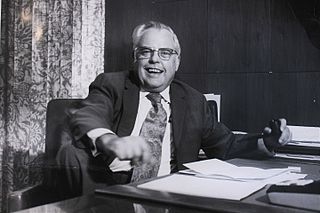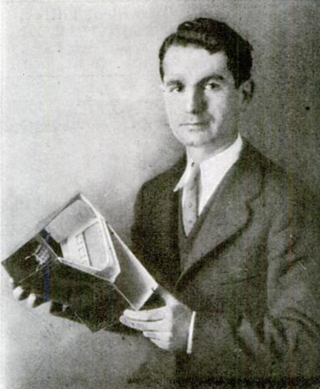
Antonio Longoria (August 14, 1890 - December 31, 1970) was a scientist who claimed to have invented a death ray in the 1930s. [1] [2] [3]

Antonio Longoria (August 14, 1890 - December 31, 1970) was a scientist who claimed to have invented a death ray in the 1930s. [1] [2] [3]
Longoria was born in Madrid, Spain, on August 14, 1890. [4] Longoria received a degree in engineering and a Ph.D. in medicine. In 1911, Longoria emigrated to the United States. Longoria moved to Cleveland, Ohio, where he married and had three children. Longoria became the president of the Sterling Electrical Company. [5] Longoria became a naturalized US citizen on December 29, 1919. [6] Longoria claimed in 1936 that patents for his process for welding ferrous and nonferrous metals by his "invisible ray" were sold for $6,000,000. [7] Longoria died on New Year's Eve, December 31, 1970, in Winter Park, Florida. [8] [9]

Philo Taylor Farnsworth was an American inventor and television pioneer. He made the critical contributions to electronic television that made possible all the video in the world today. He is best known for his 1927 invention of the first fully functional all-electronic image pickup device, the image dissector, as well as the first fully functional and complete all-electronic television system. Farnsworth developed a television system complete with receiver and camera—which he produced commercially through the Farnsworth Television and Radio Corporation from 1938 to 1951, in Fort Wayne, Indiana.

An arc lamp or arc light is a lamp that produces light by an electric arc.

Submerged arc welding (SAW) is a common arc welding process. The first SAW patent was taken out in 1935. The process requires a continuously fed consumable solid or tubular electrode. The molten weld and the arc zone are protected from atmospheric contamination by being "submerged" under a blanket of granular fusible flux consisting of lime, silica, manganese oxide, calcium fluoride, and other compounds. When molten, the flux becomes conductive, and provides a current path between the electrode and the work. This thick layer of flux completely covers the molten metal thus preventing spatter and sparks as well as suppressing the intense ultraviolet radiation and fumes that are a part of the shielded metal arc welding (SMAW) process.

Sir Hiram Stevens Maxim was an American-born British inventor best known as the creator of the first automatic machine gun, the Maxim gun. Maxim held patents on numerous mechanical devices such as hair-curling irons, a mousetrap, and steam pumps. Maxim laid claim to inventing the lightbulb.

Elihu Thomson was an American engineer and inventor who was instrumental in the founding of major electrical companies in the United States, the United Kingdom and France.

Antonio Santi Giuseppe Meucci was an Italian inventor and an associate of Giuseppe Garibaldi, a major political figure in the history of Italy. Meucci is best known for developing a voice-communication apparatus that several sources credit as the first telephone.

William Kelly, born in Pittsburgh, Pennsylvania, was an American inventor. He is credited with being one of the inventors of modern steel production, through the process of injecting air into molten iron, which he experimented with in the early 1850s. A similar process was discovered independently by Henry Bessemer and patented in 1855. Due to a financial panic in 1857, a company that had already licensed the Bessemer process was able to purchase Kelly's patents, and licensed both under a single scheme using the Bessemer name. Kelly's role in the invention of the process is much less known.

Arc welding is a welding process that is used to join metal to metal by using electricity to create enough heat to melt metal, and the melted metals, when cool, result in a binding of the metals. It is a type of welding that uses a welding power supply to create an electric arc between a metal stick ("electrode") and the base material to melt the metals at the point of contact. Arc welding power supplies can deliver either direct (DC) or alternating (AC) current to the work, while consumable or non-consumable electrodes are used.

Harry Grindell Matthews was an English inventor who claimed to have invented a death ray in the 1920s.
Graver Tank & Manufacturing Co. v. Linde Air Products Co., 339 U.S. 605 (1950), was an important United States Supreme Court decision in the area of patent law, establishing the propriety of the doctrine of equivalents, and explaining how and when it was to be used.
Shielding gases are inert or semi-inert gases that are commonly used in several welding processes, most notably gas metal arc welding and gas tungsten arc welding. Their purpose is to protect the weld area from oxygen, and water vapour. Depending on the materials being welded, these atmospheric gases can reduce the quality of the weld or make the welding more difficult. Other arc welding processes use alternative methods of protecting the weld from the atmosphere as well – shielded metal arc welding, for example, uses an electrode covered in a flux that produces carbon dioxide when consumed, a semi-inert gas that is an acceptable shielding gas for welding steel.

James Hillier, was a Canadian-American scientist and inventor who designed and built, with Albert Prebus, the first successful high-resolution electron microscope in North America in 1938.

Luther George Simjian was an Armenian-American inventor and entrepreneur. A prolific and professional inventor, he held over 200 patents, mostly related to optics and electronics. His most significant inventions were a pioneering flight simulator, arguably the first ATM and improvement to the teleprompter.

Edward Weston was an English-born American chemist and engineer noted for his achievements in electroplating and his development of the electrochemical cell, named the Weston cell, for the voltage standard. Weston was a competitor of Thomas Edison in the early days of electricity generation and distribution.

Albert Garrette Burns was president of the National Inventors Congress starting in 1931 and served until at least 1939. He was known as the "Nation's Gadget Chief".

The death ray or death beam was a theoretical particle beam or electromagnetic weapon first theorized around the 1920s and 1930s. Around that time, notable inventors such as Guglielmo Marconi, Nikola Tesla, Harry Grindell Matthews, Edwin R. Scott, Erich Graichen and others claimed to have invented it independently. In 1957, the National Inventors Council was still issuing lists of needed military inventions that included a death ray.

A timeline of United States inventions (1890–1945) encompasses the ingenuity and innovative advancements of the United States within a historical context, dating from the Progressive Era to the end of World War II, which have been achieved by inventors who are either native-born or naturalized citizens of the United States. Copyright protection secures a person's right to his or her first-to-invent claim of the original invention in question, highlighted in Article I, Section 8, Clause 8 of the United States Constitution which gives the following enumerated power to the United States Congress:
To promote the Progress of Science and useful Arts, by securing for limited Times to Authors and Inventors the exclusive Right to their respective Writings and Discoveries.

The cathode-ray tube amusement device is the earliest known interactive electronic game as well as the first game to incorporate an electronic display. The device simulates an artillery shell arcing towards targets on a cathode-ray tube (CRT) screen, which is controlled by the player by adjusting knobs to change the trajectory of a CRT beam spot on the display in order to reach plastic targets overlaid on the screen. Thomas T. Goldsmith Jr. and Estle Ray Mann constructed the game from analog electronics and filed for a patent in 1947, which was issued the following year. The gaming device was never manufactured or marketed to the public, so it had no effect on the future video game industry. Under many definitions, the device is not considered a video game, as while it had an electronic display it did not run on a computing device. Therefore, despite its relevance to the early history of video games, it is not generally considered a candidate for the title of the first video game.
The European Inventor Award, are presented annually by the European Patent Office, sometimes supported by the respective Presidency of the Council of the European Union and by the European Commission, to inventors who have made a significant contribution to innovation, economy and society, predominantly in Europe. Inventions from all technological fields are considered for this award. The winners in each category are presented with an award shaped like a sail. There is no cash prize associated with the award, however there is a cash prize for all 3 of the Young Inventors Prize finalists.

John C. Lincoln was an American inventor, entrepreneur, philanthropist and in 1924, the Vice-Presidential candidate under the Commonwealth Land Party ticket. He held 55 patents on several electrical devices, founded the Lincoln Electric Co., invested in the construction of the Camelback Inn, presided over the Bagdad Mine and funded two hospitals in Phoenix, one which bears his name.
Albert G. Burns of Oakland, Calif, was re-elected president of the Congress. It was Mr. Burns who last year revealed that a Clevelander named Antonio Longoria had invented a death-ray which killed rabbits, dogs & cats instantly. President Burns said that Inventor Longoria would withhold his secret until invasion threatened the U. S.
He is also a persistent and well-publicized ballyhooer of the 'death ray' machine he claims to have invented. Says he, this machine can kill cats and dogs, bring down pigeons on the wing, at ranges up to four miles.
Born in Madrid 46 years ago, Antonio Longoria attended Spanish schools, got a degree in engineering and a doctorate in medicine. In 1911, he arrived in the U.S., fonder of tinkering with machines than with people. Settling in Cleveland, he married, fathered three children, became president of Sterling Electrical Co.
Patents for his newly invented process of welding ferrous and nonferrous metals by means of an invisible ray have yielded Dr. Antonio Longoria of Cleveland about $6,000,000, the inventor declared yesterday when he arrived in New York City.